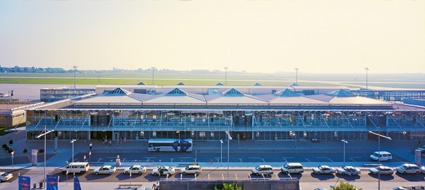The First Line of Defense in Airport Security
Due to the large and complex nature of today's airports the implementation of comprehensive security measures involves a layered strategy. This typically comprises intrusion detect...


Due to the large and complex nature of today's airports the implementation of comprehensive security measures involves a layered strategy. This typically comprises intrusion detection, wide-area video surveillance, access control and centralized management through an integrated command and control platform. Increasing security concerns have brought about a rapid pace of change at airports, with public attention focusing
on the airport terminal area. However, perimeter security solutions - while perhaps less visible to the average passenger - form a fundamental aspect of any airport security concept.
Increasing numbers of passenger and cargo traffic mean that a comprehensive strategy is more vital than ever to ensure that perimeter security and integrity is maintained under all circumstances. There have been several highly publicized incidents in recent months where
perimeter security has been breached, either inadvertently or with intent, and intruders were able to gain access to restricted airside areas with damaging and costly consequences to airport operations as well as the reputation of the airport and operator.
Customized perimeter security
Every airport with its ground layout, terminal buildings, operational modus and surroundings is unique, so a universal perimeter security approach is virtually inconceivable. Every solution needs to be tailored and customized to suit each specific site. By accurately pinpointing possible security threats at as early a stage as possible incidents outside of the normal course of events can be dealt with before they have the chance to escalate into a threat to the continuity of airport operations or pose a danger to the safety of passengers, operatives and airport assets alike. It is important to understand that even incidents that take place on the outer reaches of an airport can have far-reaching consequences and can create long-lasting damage to an airport's reputation and, ultimately, its bottom line. All incidents including malicious vandalism or attempted security breaches, through to operational risks posed by wildlife and extreme weather can have a cumulative and hugely damaging effect on an airport's standing in today's highly sensitive and competitive market.
Airport perimeters can easily extend to over
50 km in length and require the correct balance of technologies best suited to each specific environment. Traditional methods of security include a combination of both physical fences or walls and electronic detection technologies to sense any violation of the perimeter. These systems will, however, generate an alarm only whilst the security breach is either in progress or access has already been gained. At this point damage to site assets has already occurred, but more critically, the most sensitive part of the airport has now been violated with potentially dramatic consequences. Not only has this technology been prone to unwanted false alarms but it also fails to provide any situational awareness capability. It is usually impossible to accurately pinpoint the exact security breach, thus complicating the procedure to resolve the incident.
To overcome the shortcomings of more traditional perimeter security measures, the latest principles include a combination of physical measures together with intelligent external detection solutions, such as long-range thermal imaging surveillance cameras, the latest presence or movement detection sensors and ground radar tracking. They can all be deployed and managed through sophisticated perimeter detection and management platforms to identify unauthorized access well before it poses a threat to operations. The net result is that potential intruders can be monitored whilst still beyond the perimeter boundry and can be contained before they enter any critical areas.
Other breakthrough innovations that apply to airport perimeter security include live detection and tracking of objects, both vehicular
and pedestrian, throughout the airside arena. Any activity is automatically mapped against planned and authorized routes and schedules via integration with other airport databases, allowing operators to immediately recognize and react to unscheduled incidents. Detection of all activity in airside areas - both planned and unauthorized - continues to be a focus at airports around the world. With increased ground movements and many airports running at or above maximum capacity, this will become an ever more critical part of airport security operations.
With these latest technologies and solutions, security measures implemented in today's airports now go well beyond traditional passive video surveillance, and offer airport security personnel the ability to work more proactively, productively and efficiently with the solutions available to them. Through the use of automa-ted video solutions, operators are able to scan the entire airport with video surveillance camera feeds and display them on a single screen. Using intelligent policy zones and virtual barriers, security teams are alerted to live incidents as they happen throughout the entire site. Best-of-breed surveillance video platforms are typically based on open architectures and protocols allowing them to accommodate legacy installations and to be adapted to ever-changing market, customer and regulatory demands.
Reduced operational risk
Recent technological advances include video analytics that continuously supervise video surveillance images. This makes it possible to create dynamic and sophisticated detection zones in which all activity can be automatically assessed and predefined escalation can be promptly instigated as required. They give rise to fewer false alarms, identifying only highly specific pre-qualified "real" incidents and making all events easier to validate and qualify. This accurate filtering of all alarms dramatically assists the operating staff and with the assistance of predefined alarm response actions ensures compliant and validated decision-making. As a result, solutions employing quality and correctly implemented intelligent video analytics ensure less operational downtime, as well as improved operator efficiency and site security.
Perimeter security breaches in today's airport climate can result in catastrophic damage to property or even loss of life, with potentially consequential legislative implications. By adopting the latest perimeter detection solutions, airport operators can successfully and effectively prevent damaging security incidents and demonstrate to passengers as well as relevant authorities that they are implementing the highest levels of protection and the best technological security solutions currently available.
Business Partner
Siemens Smart InfrastructureTheilerstrasse 1a
6300 Zug
Switzerland
most read

Security management, building security & perimeter protection: the winners of category E at the GIT SECURITY AWARD 2026
GIT SECURITY AWARD 2026: Security management, building security & perimeter protection - an overview of the most innovative solutions

Assa Abloy's battery-powered Aperio KL100 secures lockers
Boost workplace security and operational flexibility by securing more than just doors.

VIP-Lounge Interview: Marco Mille, Global Head of Security, Siemens AG
VIP in the World of Security: Marco Mille, Global Head of Security at Siemens AG


GIT SECURITY AWARD 2026 - The winners have been announced!
GIT SECURITY AWARD 2026: The best safety and security solutions of the year - now an overview of all winners








